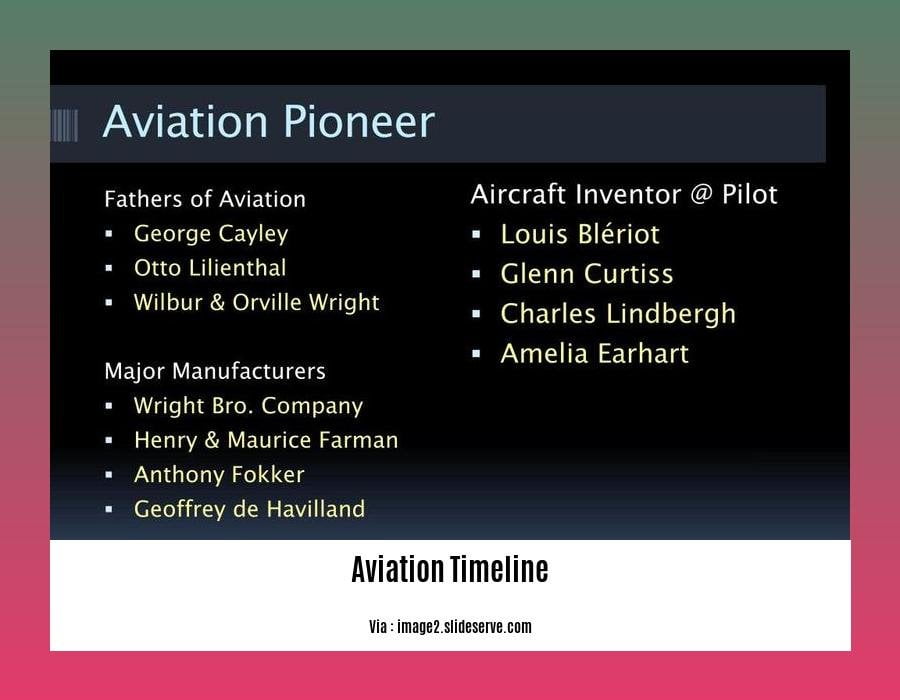Unveiling the **Aviation Timeline: Chronicling the Milestones and Advancements of Aviation**, a captivating exploration into the historical tapestry of aviation. This comprehensive journey traces the pivotal moments and technological leaps that have propelled humankind to soar through the skies, showcasing the unwavering spirit of innovation and human ingenuity that has shaped this transformative industry.
Key Takeaways:
- 1505-1506: Leonardo da Vinci’s “Codex on the Flight of Birds” laid the foundation for aerodynamics.
- November 21, 1783: The Montgolfier brothers made the first successful manned hot-air balloon flight.
- September 24, 1852: Henri Giffard’s “Giffard Dirigible” marked the first powered and controllable airborne flight.
Aviation Timeline


As we traverse the aviation timeline, we embark on a remarkable journey that has transformed the way we connect, explore, and advance. From the humble beginnings of Leonardo da Vinci’s sketches to the supersonic feats of the Concorde, aviation has left an indelible mark on our world.
Let’s explore some pivotal milestones that shaped the aviation timeline:
The Wright Brothers’ Triumph (1903)
In a field in Kitty Hawk, North Carolina, the Wright brothers, Orville and Wilbur, etched their names in the annals of aviation history. Their successful flight in 1903 marked the dawn of powered, controlled flight, forever changing the course of human transportation.
The Birth of Commercial Aviation (1911)
Just eight years later, DELAG, the first commercial airline, took flight in Germany. This marked the advent of scheduled passenger air services, connecting cities and facilitating global travel.
Aviation’s Role in War (1914-1945)
World War I and World War II catapulted aviation into military prominence. Airplanes became indispensable for reconnaissance, bombing, and transportation. The development of fighter jets and bombers showcased aviation’s transformative power in warfare.
The Jet Age Arrives (1930s)
The invention of the jet engine in the 1930s revolutionized aviation. Jet airliners could fly faster, farther, and with greater efficiency, paving the way for a new era of air travel.
The Space Race (1957-1969)
The launch of Sputnik by the Soviet Union in 1957 sparked an intense competition known as the Space Race. Aviation played a crucial role, with the development of rockets and spacecraft that propelled humans into space, culminating in the historic moon landing in 1969.
Supersonic Travel (1952-2003)
The Concorde, a supersonic airliner, made its debut in 1976, capable of flying at speeds exceeding the speed of sound. While Concorde’s commercial life was short-lived, it showcased the potential for faster-than-sound travel.
Modern Aviation (2000-Present)
The 21st century has brought about significant advancements in aviation. The Airbus A380, the largest commercial airliner, entered service in 2007. The Boeing 787 Dreamliner, known for its fuel efficiency, took to the skies in 2011.
As we continue along the aviation timeline, new technologies are on the horizon, promising to shape the future of air travel. Electric and hybrid aircraft hold the potential for more sustainable and environmentally friendly flight, while autonomous aerial vehicles offer exciting prospects for transportation and logistics.
The aviation timeline is a testament to human ingenuity, innovation, and the relentless pursuit of the skies. It’s a story of dreams taking flight and the transformative power of aviation in connecting the world, shaping global events, and inspiring generations.
Delve into the captivating history of aviation, a testament to human ingenuity and the boundless pursuit of soaring through the skies. From the earliest attempts at flight to the advent of jet travel, the history of aviation is a chronicle of innovation and unwavering determination.
Uncover the intricacies of aircraft development and witness how advancements in aerodynamics and technology have shaped the skies we fly today. The history of flight provides a comprehensive account of the groundbreaking moments that have forever altered the course of aviation.
The International Air Transport Association (IATA) is founded
The postwar era witnessed the birth of the International Air Transport Association (IATA). This pivotal event in 1945 brought together airlines from around the globe, marking a new chapter in global aviation collaboration.
Key Takeaways:
- IATA’s mission was to promote the safe, reliable, secure, and economical operation of air services.
- It played a crucial role in streamlining international air transport, setting standards, and facilitating cooperation among member airlines.
- IATA’s efforts contributed significantly to the growth and development of commercial aviation worldwide.
[Source:
The first commercial jet airliner, the de Havilland Comet, is introduced
As a pioneer in aviation history, the de Havilland Comet took to the skies, forever etching its name in the annals of air travel. This groundbreaking aircraft, hailing from the United Kingdom, boasted a sleek and aerodynamic design that housed four de Havilland Ghost turbojet engines within its wing roots.
The Comet’s most striking feature was its pressurized cabin, a marvel that offered unprecedented comfort and convenience for passengers. Unveiled in 1949, it entered commercial service in 1951, marking a pivotal moment in the industry.
Despite its promising start, the Comet’s legacy is tinged with tragedy. A series of fatal crashes marred its reputation, ultimately grounding the aircraft and leading to extensive modifications. Nonetheless, the Comet’s pioneering spirit laid the groundwork for the jetliners that revolutionized air travel in the decades that followed.
Key Takeaways:
- The de Havilland Comet was the first commercial jet airliner.
- It introduced a pressurized cabin, enhancing passenger comfort.
- Despite early success, the Comet faced challenges due to structural flaws.
- The Comet’s legacy remains as a stepping stone in the development of modern jetliners.
Citation:
The first humans land on the moon
Prepare for liftoff as we embark on a journey to the moon, a colossal leap for humankind! On July 20, 1969, Apollo 11 touched down on the lunar surface, etching Neil Armstrong’s name in history as the first person to step foot on an extraterrestrial world.
Key Takeaways:
– Apollo 11 was a pivotal moment in the Cold War space race between the United States and the Soviet Union.
– President Kennedy had set the ambitious goal of landing a man on the moon before the end of the 1960s.
– Armstrong’s famous words, “That’s one small step for [a] man, one giant leap for mankind,” encapsulate the magnitude of this achievement.
Citation:
– Apollo 11 – Wikipedia
FAQ
Q1: What is the significance of Leonardo da Vinci’s “Codex on the Flight of Birds”?
A1: Leonardo da Vinci’s “Codex on the Flight of Birds” laid the foundation for the study of aerodynamics, providing insights into the principles of flight observed in birds.
Q2: Who conducted the first successful manned hot-air balloon flight?
A2: Joseph-Michel and Jacques-Étienne Montgolfier conducted the first successful manned hot-air balloon flight on November 21, 1783, marking a pivotal milestone in aviation history.
Q3: Describe the role of Henri Giffard’s “Giffard Dirigible” in the development of powered flight.
A3: Henri Giffard’s “Giffard Dirigible,” demonstrated in 1852, was the first successful powered and controllable airship, showcasing the potential for controlled airborne flight.
Q4: What was the significance of the International Air Transport Association (IATA)?
A4: The International Air Transport Association (IATA), founded in 1945, is a key organization in the aviation industry, facilitating inter-airline cooperation, setting standards, and advocating for sustainable practices.
Q5: Explain the legacy of the de Havilland Comet jet airliner.
A5: The de Havilland Comet, developed in the UK, was the first commercial jet airliner, featuring an aerodynamic design. Despite its initial success, it was marred by tragic accidents due to design flaws, leaving a complex legacy that contributed to advancements in jetliner technology.
















